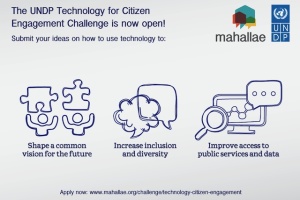 Just found this out: the city council of Ivano-Frankivsk, a municipality in Western Ukraine, initiated a project for the creation of a mobile app to improve service delivery and expand opportunities for collecting the public’s feedback. On 18 January 2014, UNDP help to launch the app, making it available for free on Google Play. “Containing information about the city, its executive authorities, and a useful telephone directory of 500 contacts of relevant public authorities, the app also provides easy access to municipal emergency services. Crucially, it also allows citizens to report cases of corruption via 14 different anti-corruption hotlines at local, regional, and national levels. The claims and petitions filed will be addressed within the legally established timeframe of 30-45 days.” Here’s the official story from UNDP Europe and Central Asia.
Just found this out: the city council of Ivano-Frankivsk, a municipality in Western Ukraine, initiated a project for the creation of a mobile app to improve service delivery and expand opportunities for collecting the public’s feedback. On 18 January 2014, UNDP help to launch the app, making it available for free on Google Play. “Containing information about the city, its executive authorities, and a useful telephone directory of 500 contacts of relevant public authorities, the app also provides easy access to municipal emergency services. Crucially, it also allows citizens to report cases of corruption via 14 different anti-corruption hotlines at local, regional, and national levels. The claims and petitions filed will be addressed within the legally established timeframe of 30-45 days.” Here’s the official story from UNDP Europe and Central Asia.
Ukraine really is quite a tech-savvy country – as I mentioned earlier, re: the late Ukrainian journalist Ihor Kostenko, who was killed earlier this year in a Euromaidan protest, being named Wikipedian of the Year for 2014. And, as you may recall, I blogged earlier about the development of a citizen reporting system for post-conflict areas in Ukraine, one that could be accessed by a computer or a smart phone, where citizens could report on a particular issue, and these reports could be mapped and shared, etc.
But with all that said, just as with app launches and hackathons / hacks4good in the USA, there seems to be no followup. Are any of these apps4good projects sustainable? Are there more users of the apps now? How many cases of corruption have been reported to date with this particular app that was launched earlier this year? Has the app – or any apps six months later – been improved in any way? Has any hackathon products or apps4good had any evaluation yet and, if so, what are the results?
I’ve been trying to find examples of citizen reporting apps being used by governments to respond to citizen reports – about illegal waste dumps, infrastructure issues, misuse of official vehicles, whatever, in any country. And so far… I’m finding only stories about the launch of the app. Like this one in Montenegro. In addition to getting answers to the questions in the aforementioned paragraph about all these apps for good, I’d like to read a success story about the government being responsive to the data generated. It seems to me some of the requirements for this to happen would be:
- the government designating an office and at least one staff position as being responsible for reading every submission, evaluating it, passing it on to the appropriate people for action, and following up to make sure action was taken – and if not, getting back to the reporting citizens as to why not.
- the office and staff people assigned to be responsible for reading and responding to the data generated by the citizen reporting app being evaluated regarding their performance in responding to the information, and that evaluation being made public.
I did hear of one project in Kyiv, where citizens can report housing problems via a web site, and, according to the person that referred such to me, it is actually working: “There is a system that a person leaves a request (reports a problem), the housing department employee checks it, and fixes the problem and reports back on it.” So it seems to be working exactly because it’s addressed the two aforementioned bullet points – or, as my colleague put it, “such a system can work only with local authorities, who will implement the projects, and have access to the ground, and resources.”
It’s wonderful to see so many tech4good / apps4good / hacks4good initiatives anywhere in the world, Ukraine or otherwise, but I fear we’re spending all our attention on their launch, and not nearly enough on their impact and sustainability. And if we don’t focus on those things, then they are just tech fluff.
Greetings from Ukraine.



